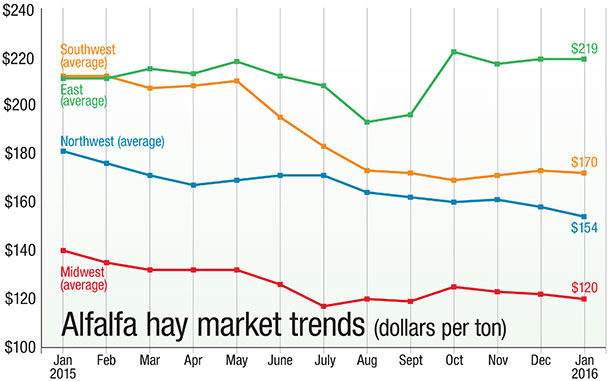While prices are down for cattle, milk, corn and most commodities, and many farmers have carryover loan debt from the previous season, the trending report (Figure 1 and 2) shows hay prices holding. Granted, the prices that are holding aren’t anything to brag about, but they are nonetheless not sliding.
Alfalfa
Actual hay prices received for January 2016, as reported by the USDA’s National Agricultural Statistics Service (NASS) on Feb. 29, showed a 2 percent decrease in overall pricing across the U.S. for alfalfa hay. Winners during January included Arizona (14 percent increase to $160 per ton) and Wisconsin (increase of 12 percent to $110 per ton). Stockpiled supplies in Idaho slowed the market to $170 per ton (decrease of 11 percent over December 2015), and in Oklahoma prices dropped 11 percent to $161 per ton.
Other hay
Actual hay prices received for “other hay” (all hay including grasses) varied from a low of $56 in North Dakota (down 2 percent) to a high of $209 per ton in Pennsylvania (still down 11 percent over the previous month’s $234). The national average showed a decrease of 6 percent in prices received for January, as compared with December 2015.
Exports
The USDA Foreign Agricultural Service reported in December 2015 an average decrease of 13 percent in export hay to the top six hay-trading partners of Japan (down 12 percent), China (up 5 percent), South Korea (down 15 percent), United Arab Emirates (down 11 percent), Taiwan (down 10 percent) and Saudi Arabia (down 35 percent). Quantity shipped to these six partners in December 2015 was 277,486 metric tons.
Weather
Do you have cabin fever yet? The USDA Weekly Weather and Crop Bulletin for the week of Feb. 20 shows most of the nation at least got a peek at spring. Temperatures in the South and Southern Plains reached mid 80°F, while temperatures in the 50s and 60s prevailed over most of the northern U.S. Not bad. Not bad at all. The downside is that some wheat began coming out of dormancy, which could be damaging so early in the spring. Higher temperatures also raised concern of a too-early snowpack melt across the Sierra Nevada range. Cooling temperatures later in the week slowed the melt, however, and stabilized the snowpack.
But it wasn’t warm and cheery everywhere. Watertown, New York, was caught in the Valentine’s Day cold spell, recording the lowest February temperature on record. In addition, the Southeast weather spawned more than two dozen tornadoes.
Dairy
Not good news, but not unexpected either, milk prices in January dropped another dollar over December 2015 pricing, to $16.10 per hundredweight. With lower corn prices, producers look to include more corn in rations again – not a scenario we’re unfamiliar with. Stockpiled forages from the past two years also look to keep new hay sales slow.

Trending charts
Several forces can impact hay market trends – hay quality, interest rates, feed commodity prices, oil prices, crop input costs, weather, transportation costs, milk prices, inflation and international issues. The best way to understand market fluctuations is to study trends in relation to such events. There is value in keeping track of upswings and downturns over several months (or years) to help with buying and selling decisions. Thus, trends may become a critical barometer for producers, brokers, dairymen and livestock producers.
Furthermore, hay markets vary widely by region and by product – alfalfa hay versus “other hay.” “Other hay” is a term used by the USDA to include all grass hay types.
The prices and information in Figure 1 (alfalfa hay market trends) and Figure 2 (“other hay” market trends) are provided by NASS and reflect general price trends and movements. Hay quality, however, was not provided in the NASS reports.
For purposes of this report, states that provided data to NASS were divided into the following regions:
Southwest – Arizona, California, Nevada, New Mexico, Oklahoma, Texas
East – Kentucky, New York, Ohio, Pennsylvania
Northwest – Colorado, Idaho, Montana, Oregon, Utah, Washington, Wyoming
Midwest – Illinois, Iowa, Kansas, Michigan, Minnesota, Missouri, Nebraska, North Dakota, South Dakota, Wisconsin FG











